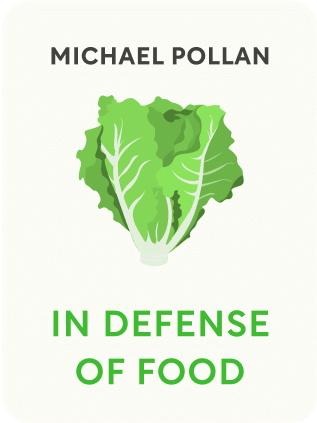

This article is an excerpt from the Shortform book guide to "In Defense of Food" by Michael Pollan. Shortform has the world's best summaries and analyses of books you should be reading.
Like this article? Sign up for a free trial here .
Do you want to start eating healthier but not sure where to start? What are some healthy eating tips that can help you set your diet on track?
There is more to eating healthy than just diet. The culture surrounding how we eat and our approach to food are just as important. The quality of food, taking meals over snacks, listening to your body, and eating slowly are some of the simple yet essential healthy eating tips.
Keep reading for more heathy eating tips.
Healthy Eating Tips: Beyond Diet
If you’re looking for healthy eating tips, keep in mind that healthy eating is so much more than just consuming a certain amount of certain nutrients. The sociology of food is a major component of healthy eating. It involves habits, customs, manners, and the way we eat. Following traditional dietary patterns is just one step toward health. Following the customs of a culture is the other step.
When scientists ponder the French paradox, they only notice a diet of rich foods and wine and thinner, healthier eaters. What they don’t consider is the relationship those eaters have with the food and culture surrounding how they eat. If they did, they’d see that the French don’t snack and eat mostly meals in social environments. Their portions are small, and they eat at a slower pace. They eat fewer calories and enjoy the experience of eating.
Psychologists refer to something called “unit bias,” which means people tend to believe whatever portion they’re served is the right amount to eat. This is why portion size matters. Plus, when you eat smaller portions more slowly, you allow the food to be savored rather than devoured, leaving you wanting more. Americans could learn a lot from the habits of the French and other cultures regarding how to eat, and the following tips can serve as a healthy eating guide.
Tip #1: Spend More Money on Food
To benefit your health and the health of the food chain, spend more money on food so you are buying better food both in nutritional value and quality. The French seem to accept the trade-off between quality of food/eating experience and the cost of eating. But we are geared toward quantity and cheap, accessible food.
The American mentality has been to deliver large amounts of food packaged inexpensively for decades. This mindset serves many people well, as many can’t afford to spend a lot of money on food. But many of us can and choose not to. In fact, Americans spend less than 10% of their income on food, the lowest percentage of all other industrialized populations.
More expensive food is often so because it has required more care and energy to produce, rather than being mass-produced in factories, stockyards, or single-crop farms. These foods are better for you because of a lack of toxins or improved nutritional quality. Also, you’re more likely to eat less food when it costs more.
The lure of high-calorie products is their cheap price and convenience. This food is easy to eat and requires little effort to prepare or clean-up thanks to the invention of the microwave. These factors cause people to eat more. If we had to make our own junk food, such as baking our own hostess cakes or frying our own potato chips, we would eat less. You’ll eat less food if it is more expensive and requires more effort to prepare.
The advice to “eat less” is not part of the American vocabulary and hasn’t been since McGovern’s revisions of the dietary guidelines in the 1970s. The culture is inundated with cheap calories, and no aspect of our eating customs points away from indulging, like in other cultures. For instance, second portions are taboo in France. In Okinawa, Japan, a region boasting some of the oldest and healthiest people, they eat following the principle of “hara hachi bu,” or eat to 80% fullness.
We, on the other hand, eat until an external cue tells us to stop, even when full—an empty chip bag, an empty plate, or the end of a movie or TV program. This behavior has led to a society with increasing waistbands and declining health, and the cost of food has matched these trends. Since the changes in agricultural policies in 1980, obesity rates have grown steadily with the additional 300 more calories per person per day. Most of these calories come from sweeteners and fats derived from corn and soy, which has decreased in price by 20% since that time. Conversely, the price of fresh produce has increased by 40%.
Ironically, as money spent on food decreased, the amount spent on health care increased. In 1960, Americans spent 17.5% of their income on food and 5.2% on health care. Today, the 10% spent on food is paired with 16% spent on health care. Many believe the increase in calories is the main culprit and that reducing calories is the key to cancer prevention.
- Overeating promotes rapid cell division, especially cancer cells. When calories are reduced, this process slows. When this process slows, fewer free radicals are produced. Inflammation is also reduced.
You are more likely to savor the food more when you spend more on food and eat less. Eating healthier foods is a better food experience, and you’ll be satisfied with the smaller portion more than if you eat until you’re stuffed.
Tip #2: Meals Over Snacks
If you eat only three meals a day—breakfast, lunch, and dinner—and eat them with other people, you can reduce your caloric intake and promote a positive food culture. Americans tend to eat more snacks than meals, especially meals with other people. In fact, researchers have ceased studies that strictly focus on the big three meals. They now include a fourth “meal occasion,” that of all-day continual snacking and drinking of processed beverages.
Why is this a big deal? Those of a certain age will remember the culture of family meals and the benefits gained.
- People socialized around a table, sharing knowledge and intimacy.
- Parents modeled positive eating habits, such as eating healthy portions or not wasting food.
- Children learned manners and how to converse socially.
At one point, American culture was defined by group and family meals. Not anymore. One study found that one-fifth of all eating for people aged 18 to 50 years old happened in the car. And although many families state they eat 3 or 4 meals together a week, those meals resemble little of the old customs.
Family members now tend to forage for their own meals before sporadically making their way to the communal table, if they do at all. As soon as they’re finished eating, they leave the table. The food industry has conducted studies to observe the habits of families during meals, and seeing this new trend, they now market what they call “home meal replacements” to families. Each member can eat what they desire, whether low-carb, low-fat, low-cholesterol, or high-calorie. Portion sizes are dictated by whatever company packaged these ready-to-serve meals.
Social graces and culture have very little to do with the way American families eat these days. Still, nothing has threatened the Norman Rockwell culture more than snacks. Snacking now occurs in places that were once food-free environments. For instance, workplaces have well-stocked kitchens, and a box of pastries or bagels can often be found in work meetings. Times between meals are filled with foods packaged specifically for snacking.
Our snacking culture is so big, cars were redesigned to support it. Cup holders are large enough to fit a bottle of soda or Big Gulp. Glove compartments are refrigerated. And snack portions continue to grow. These snacks are rarely fruit slices or vegetable sticks. They are flavored, processed refined carbs, hydrogenated oils, salt, and sweeteners. This culture is so ingrained, changing it must be intentional. The following considerations can help.
1. Eat only at a table.
- A desk or bed or car seat is not a table. To curb your snacking, eat only when you are seated at a proper table.
2. Don’t buy food from gas stations or convenience stores.
- The corn industry’s best client is the gas station. They provide ethanol for your car and high-fructose corn syrup for you. In fact, people spend more money at gas stations on snacks and sodas than on gas. And gas station food is never high-quality and rarely nutritious.
3. Eat with others when possible.
- Communal eating helps curb overeating, likely because there’s an active audience to judge your consumption. You are also more likely to be careless in food choices and mindless about portioning when you eat alone. Food marketers know this and spend millions to make it possible for you to eat quickly by yourself. Plus, when you eat alone, you aren’t supporting a positive or social food culture.
Tip #3: Listen to Your Body
When external cues drive your eating habits, you’re likely to eat more than you need. When you allow other senses to guide what and how you eat, you’re likely to eat less. Other senses can lead to the following questions:
- Is this food as pleasing to the nose as it is to the eye?
- Does the food still taste good, or am I just eating to finish?
- Am I still hungry or simply still eating?
Science suggests that it takes 20 minutes for the stomach to signal the brain when full, but Americans tend to eat meals at a faster rate. You can be finished gorging before your body has time to react. When you eat slowly, you allow the body to feel satisfied and act accordingly. This is likely what makes the French paradox so compelling.
Until our culture shifts to slower rates of eating and internal cues for guidance, the following manipulations of external cues can help: serve smaller portions, use smaller plates, repackage snacks into smaller sizes, use tall glasses, make healthy foods available and visible, stick unhealthy foods in the back, and serve food from cookware in the kitchen, rather than in serving dishes on the table.
Still, a complete shift to slower eating is the best option for many reasons, as the next rule suggests.
Tip #4: Don’t Rush Food
You gain more respect for the overall health of the food chain and promote food culture when healthy food is prepared and enjoyed intentionally. This belief is what the Slow Food Movement (Slow Food) was founded on. The movement was developed in Italy as a response to the hostile takeover of the Western diet in Rome when fast food chains were introduced in the 1980s. The movement seeks to reclaim and introduce the traditional culture of eating healthier foods consciously grown, prepared, and eaten communally.
Quality is the priority of Slow Food, for the belief is that a focus on quality will awaken an appreciation for sensory pleasures and bridge the expanding gap between eaters and food producers. The suggestion is that reestablishing an appreciation for food is the proverbial straw needed to break the back of fast-paced, individually driven societies, like ours.
Slow Food is a hard sell in America because it would require a shift in national culture along with food culture. We value success and hard work over everything else, including time off and community bonding. Fast food fits this frenzied, distracted way of life. We don’t want to slow down to think about what to eat, let alone what is in what we’re eating, which is precisely what food manufacturers are counting on.
Take the fast-food hamburger. This hamburger is engineered with flavorings to make it more succulent. It is made to be devoured, thereby reducing the amount of time you have to think about where it comes from. You likely wouldn’t get past the first bite if you considered the conditions of the stockyards, slaughterhouses, or thousands of workers toiling at precarious factory jobs for minimum wage.
In contrast, a grass-fed burger made at home is more enjoyable to eat. First, it’s healthier for you. Second, with the knowledge of where the beef comes from, you can imagine pastured cows grazing and skilled workers humanely producing the meat. The food feels better intellectually and tastes better, giving you a greater sense of appreciation for what you’re eating.
Appreciation for food is found when eating becomes intentional, rather than habitual. Even something as simple as growing a few herbs at home can help you feel more connected to your food, which leads to the next rule.

———End of Preview———
Like what you just read? Read the rest of the world's best book summary and analysis of Michael Pollan's "In Defense of Food" at Shortform .
Here's what you'll find in our full In Defense of Food summary :
- Why eating a Western diet is killing you
- How the rise of low-fat foods contributed to the rise of obesity and diabetes
- What to eat if you want to restore a healthy relationship with your food






